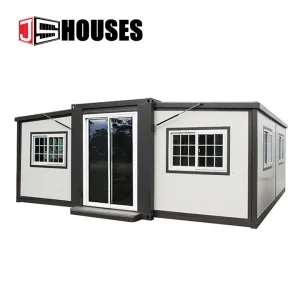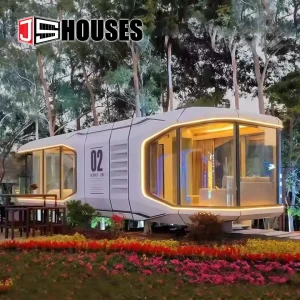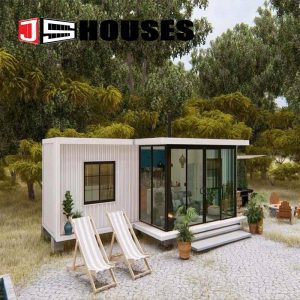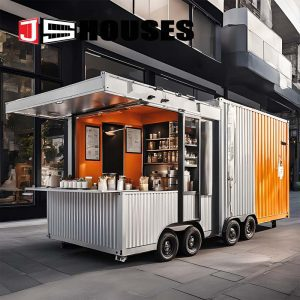How much is a prefab container house?
Demystifying the Cost of a Prefab Container House: A Comprehensive Guide
The allure of prefab container houses is undeniable. They represent a blend of industrial chic, sustainability, and modern efficiency, capturing the imagination of homeowners, architects, and innovators worldwide. The image of a sleek, modular home made from repurposed shipping containers seems to promise an affordable and rapid path to homeownership. However, the most common and crucial question remains: “How much is a prefab container house?”
The short, and often frustrating, answer is: It depends. The price is not a single figure but a spectrum, ranging from as low as $15,000 for a basic, self-built unit to over $500,000 for a luxurious, architect-designed residence. The final cost is a complex equation factoring in size, condition of containers, design complexity, location, and the level of finish.
This guide will deconstruct this equation, providing a detailed breakdown of costs, the factors that influence them, and a realistic roadmap for budgeting your container home project.

The Core Spectrum: From DIY Box to Luxury Abode
Before diving into the details, it’s essential to understand the broad price tiers:
- Basic DIY & Kits ( $15,000 – $50,000 )
- What it is: A single, used container with minimal modifications (e.g., a door and window cutout, basic insulation). Often sold as a “kit” that an owner with significant construction skills can assemble.
- Suitable for: A tiny home, a backyard office, a storage shed, or a rustic cabin. This price typically excludes foundations, utilities, and interior finishes.
- Turnkey Single-Container Homes ( $50,000 – $120,000 )
- What it is: A fully finished, livable home from a single 40ft container. This “turnkey” price usually includes design, engineering, foundations, container modification, insulation, plumbing, electrical, and basic interior finishes.
- Suitable for: A compact, efficient home for one or two people. Companies specializing in these offer catalog designs for a predictable price.
- Multi-Container Custom Homes ( $120,000 – $300,000+ )
- What it is: The most common scenario for a family home. This involves combining multiple containers (e.g., 2-4) to create a larger living space with a more complex layout. Costs escalate with the complexity of engineering, welding, and design.
- Suitable for: A standard single-family home with 2-3 bedrooms, modern amenities, and custom architectural features.
- High-End Architectural Masterpieces ( $300,000 – $1,000,000+ )
- What it is: These projects use containers as a structural element in a much larger vision. Costs are driven by high-end materials (e.g., full-height glazing, green roofs), complex structural engineering, premium interior finishes, and the fees of renowned architects.
- Suitable for: Clients for whom budget is secondary to achieving a unique, sustainable, and statement-making property.
The Detailed Cost Breakdown: Where Does Your Money Go?

To understand the final price, you must dissect the project into its component costs.
1. The Container Unit(s) Itself: The Blank Canvas ( $1,500 – $8,000 each )
This is your raw material, and its condition is a primary cost driver.
- Used (“One-Trip”) Containers ( $1,500 – $4,500 ): The most popular and sustainable choice. A “one-trip” container has made only one international journey, so it’s typically in excellent structural condition with minor cosmetic dents and scratches. They require thorough sandblasting and repainting.
- New Containers ( $4,000 – $8,000 ): Also known as “one-way” containers, these are pristine, with no wear and tear. They are ideal for projects requiring a perfect start but come at a premium and are less environmentally friendly.
- High-Cube Containers: An extra foot of height (9ft 6in vs. the standard 8ft 6in) costs about 10-15% more but dramatically improves the interior feel and design flexibility.
2. Site Preparation & Foundations ( $5,000 – $30,000+ )
The container must sit on a stable, level base. This cost is highly location-dependent.
- Site Work ( $2,000 – $10,000 ): Includes clearing, grading, and ensuring proper drainage.
- Foundation ( $3,000 – $20,000+ ): Contrary to popular belief, containers rarely just sit on the ground. Common foundations include:
- Concrete Pier Foundation: The most common and often most affordable option. Concrete piers are poured at strategic points to support the container’s corners.
- Strip Footings: Continuous concrete footers that provide excellent support for multiple containers in a line.
- Slab-on-Grade: A full concrete slab. It’s more expensive but provides a ready-made floor and is ideal for integrating radiant heating.
3. Design, Engineering & Permits ( $5,000 – $30,000+ )

This is the “brain” of the operation and is not a place to cut corners.
- Architectural Design ( $3,000 – $20,000 ): A custom design from an architect experienced with containers is crucial. They will create plans that maximize space, ensure structural integrity when cutting the steel, and navigate building codes.
- Structural Engineering ( $1,500 – $7,000 ): Any modification—cutting openings, stacking containers, or removing walls—compromises the container’s structural strength. An engineer calculates how to reinforce it (with steel I-beams, moment frames, etc.) to be safe and meet code.
- Permits ( $500 – $5,000 ): Fees vary wildly by municipality. Some areas have clear guidelines for alternative housing, while others are hesitant, requiring more documentation and justification.
4. Modification & Construction: The Heart of the Project ( $20,000 – $150,000+ )

This is where the container is transformed into a house and represents the largest variable in cost.
- Cutting and Welding ( $5,000 – $25,000 ): Every door, window, and opening requires precise plasma cutting. Combining containers involves cutting away entire walls and welding the structures together, a skilled and labor-intensive process.
- Insulation and Vapor Barrier ( $3,000 – $15,000 ): Steel is a thermal bridge—it conducts heat and cold extremely efficiently. Proper insulation is critical for comfort and energy efficiency. Options include:
- Spray Foam: The most effective method for containers, as it provides a seamless air and vapor barrier while adding structural rigidity.
- Panel Systems (e.g., SIPs): Rigid panels attached to a newly built internal frame.
- Batt Insulation: The least effective for the steel box environment, as it can leave gaps for condensation.
- Roofing ( $2,000 – $10,000 ): The corrugated steel roof of a container is not designed for long-term weathering. Most projects add a new roof system, which could be a standing-seam metal roof, a green (living) roof, or a conventional shingled roof on a new frame.
- Exterior Cladding & Painting ( $5,000 – $20,000 ): While many love the industrial look, some choose to add exterior cladding (wood, metal, stucco) for better aesthetics and additional insulation. High-quality, durable marine-grade paint is essential.
5. Systems: Making it a Livable Home ( $25,000 – $75,000+ )

- Plumbing ( $8,000 – $20,000 ): Running water and waste lines through a steel structure requires careful planning. “Wet walls” are often designed to consolidate plumbing runs.
- Electrical ( $7,000 – $15,000 ): Includes wiring, outlets, lighting, and the electrical panel. Conduit is often run exposed for an industrial look or hidden within new interior walls.
- HVAC ( $5,000 – $20,000 ): A standard forced-air system may not be feasible. Mini-split ductless systems are extremely popular for their efficiency and space-saving design. A high-performance heat recovery ventilator (HRV) is also highly recommended due to the airtight nature of a well-insulated container.
- Windows and Doors ( $5,000 – $20,000 ): Custom-sized, high-performance windows and doors are a significant expense but are vital for energy efficiency, light, and the overall aesthetic.
6. Interior Finishes ( $10,000 – $100,000+ )

This is the ultimate wild card, entirely dependent on taste and budget.
- Basic Finishes: Plywood walls, vinyl flooring, and stock cabinets.
- High-End Finishes: Drywalled walls, hardwood or polished concrete floors, custom cabinetry, and premium appliances.
The Hidden Costs and Challenges
Beyond the direct construction costs, several other factors can impact your budget:
- Delivery and Crane Rental ( $1,000 – $10,000 ): Transporting a 40ft steel box requires a heavy-duty truck and often a police escort. Placing it on the foundation requires a crane.
- Condensation: This is the single biggest technical challenge. Without a perfect vapor barrier and ventilation, condensation will form on the steel interior, leading to rust and mold.
- Toxic Materials: Used containers may have been exposed to or treated with pesticides or other chemicals from their shipping days. The floor is often made of toxic hardwood. Sandblasting and sealing are mandatory.
- Limited Width: The 8-foot internal width (before insulation) feels narrow. Creative design is needed to avoid a “tunnel” effect.
Conclusion: Is a Container Home Truly Cheaper?
So, back to the original question: How much is a prefab container house?
A realistic budget for a comfortable, well-built, turnkey 2-container (approx. 640 sq ft) home that is ready to live in will likely start at $150,000 to $250,000. This translates to roughly $200 to $350 per square foot, which is often comparable to, or sometimes even exceeds, the cost of conventional stick-built construction in many areas.
The value of a container home, therefore, is not necessarily in its lower cost, but in its unique value proposition:
- Speed of Construction: The modular nature can significantly reduce on-site construction time.
- Strength and Durability: They are inherently resistant to pests, fire, and extreme weather.
- Sustainability: Repurposing a container is a brilliant form of recycling.
- Modularity and Mobility: The potential for expansion or relocation is built-in.
- Aesthetic Appeal: The industrial, modern look is a primary draw.
Final Recommendation: Approach a container home project not as a way to save money, but as a way to invest in a unique, efficient, and sustainable lifestyle. Your first step should not be to buy a container, but to consult with an experienced architect and builder, and develop a detailed budget based on your specific goals and location. Only then can you accurately answer the question: “How much will my prefab container house cost?”

